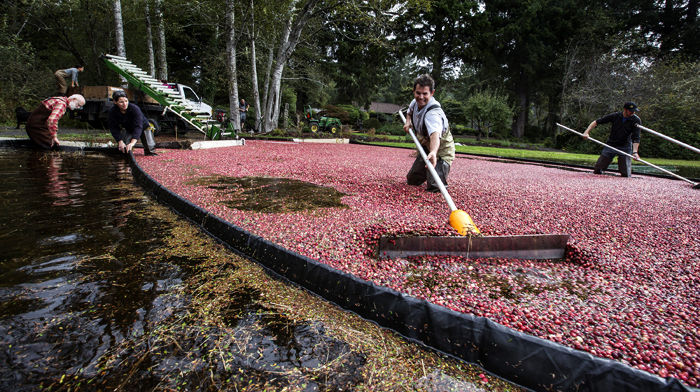Contending with crop threats
Ismet Gervalla, center, and Matthew Smith, far right, harvest cranberries, an October ritual at Starvation Alley Farms in Long Beach, Wash., the state’s first certified organic cranberry grower. (Ellen M. Banner/Seattle Times/MCT)
November 5, 2015
When organic deterrents such as garlic oil, sound waves and electricity fail, cranberry researchers turn to pesticides to control burrowing shrimp.
Kim Patten, director of the Pacific Coast Cranberry Research Station in Long Beach, Washington, started this position 25 years ago after leaving his tenured position at Texas A&M University.
When Washington State University decided to close the research station in 1992, cranberry growers formed the Pacific Coast Cranberry Research Foundation to purchase the station. WSU continues to support the personnel while local growers work as a community to farm the bogs.
Although he was hired to specifically work with cranberry growers to create a sustainable and viable industry, Patten has taken on multiple other projects including finding a control for burrowing shrimp.
Burrowing shrimp live two feet below the ground in tide flats and are a bioturbator, meaning they constantly move sediment.
“Bioturbation causes problems for commercially grown clams and oysters that sink in the mud and suffocate,” Patten said.
Patten has received blowback for being an avid supporter of the use of pesticides, fungicides and herbicides to take on the pests, diseases and weeds that infest the areas surrounding Willapa Bay.
“Patten is always on the forefront of chemicals that are out there and need to be tested,” said cranberry grower Malcom McPhail.
Both cranberry and shellfish growers deal with more than 20 major weed problems that Patten tries to stay ahead of.
Patten was the focus of vicious social media attacks earlier this year when shellfish growers gave up a permit from the Washington Department of Ecology to spray burrowing shrimp with imidacloprid, a chemical most commonly used on land crops.
Imidacloprid was approved for use in the bay by the U.S. Environmental Protection Agency and the Washington State Department of Agriculture. However, this did not stop critics from creating large amounts of bad publicity and sending threats of consumer boycotts.
“Patten brings things to the growers’ attention before it causes a problem on the farms,” said shellfish grower Marilyn Sheldon. “This is especially important when it takes five to 10 years to find solutions to pests.”
Marilyn and her husband Brian call Patten the “type of extension agent we should all strive to be.” During his 25-year career at the center he has served on the local school board, helping students prepare for college.
“He is an avid community member and a growers advocate,” McPhail said. “I can’t say enough nice things about him.”





















